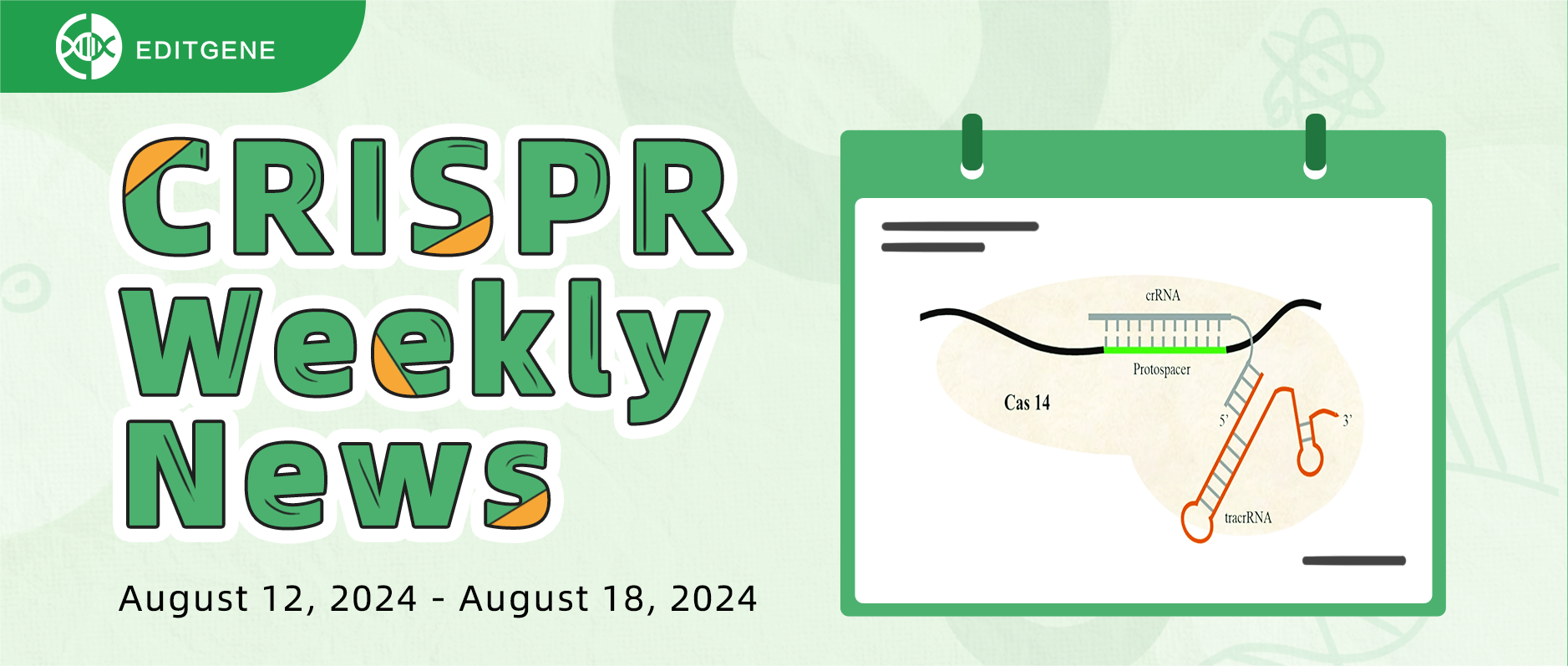[Weekly News] A Novel type VII CRISPR-Cas system: Discover the Potential of CRISPR Gene Editing

The CRISPR/Cas system represents a revolutionary technology in the field of modern biological sciences, with applications expanding into various areas such as medicine, agriculture, and ecological conservation. Relevant achievements and examples of its applications continue to emerge. "CRISPR Highlights" features a weekly news segment aimed at providing you with the latest research and industry updates regarding CRISPR. Below is a summary of the key news from the past week:
I. Research Update
a) CRISPR Knockout
1. Article Title: CRISPR-Cas9-mediated genome editing delivered by a single AAV9 vector inhibits HSV-1 reactivation in a latent rabbit keratitis model
Journal: Molecular Therapy Methods & Clinical Development
Link: https://doi.org/10.1016/j.omtm.2024.101303
Herpes Simplex Virus 1 (HSV-1) keratitis is a significant cause of blindness, particularly in developed countries. Recently, researchers from the United States assessed the therapeutic potential of EBT-104, a candidate that employs CRISPR-Cas9-mediated genome editing. The study involved the design of four guide RNAs (gRNAs) targeting the ICP0 and ICP27 genes of HSV-1. Following a comparative evaluation, the most efficient gRNA pair (ICP0g2/ICP27g1, designated as SaCas9-g2g1) was selected and subsequently packaged into an all-in-one (AIO) AAV9 vector. This AAV9 vector was administered in a rabbit model of latent HSV-1 keratitis through corneal scarification and intravenous injection. The results indicated that a single dose of the AAV9 AIO CRISPR-Cas9 gene editing system effectively targeted latent HSV-1 reservoirs and inhibited viral reactivation. This innovative CRISPR-Cas9-mediated gene editing approach significantly reduced viral load and suppressed viral reactivation in both cellular and rabbit models, highlighting its potential as a curative treatment for HSV-1 keratitis.
2. Article Title: Beyond CAR-T: The rise of CAR-NK cell therapy in asthma immunotherapy
Journal: Journal of Translational Medicine (IF:6.1)
Link: https://doi.org/10.1186/s12967-024-05534-8
Asthma is a chronic inflammatory airway disease affecting millions worldwide, with current therapies focusing primarily on symptom relief rather than the underlying pathophysiology. Recent research from Iran proposes a CRISPR-mediated strategy enhanced by AI to explore how Chimeric Antigen Receptor Natural Killer (CAR-NK) cell therapy can target and eliminate inflammatory cells related to asthma. Preclinical studies have shown that CAR-NK cells significantly reduce airway inflammation and improve lung function in animal models, indicating their potential to positively modulate the immune response in asthma patients. However, addressing challenges such as off-target effects and immune-related adverse events is crucial for ensuring long-term safety and efficacy. With advancements in CRISPR gene editing technology, CAR-NK cell therapy offers a promising therapeutic option for asthma management.
b) CRISPR Screening
1. Article Title: Removal of TREX1 activity enhances CRISPR-Cas9-mediated homologous recombination
Journal: Nature Biotechnology - Nature (IF:33.1)
Link: https://doi.org/10.1038/s41587-024-02356-3
TREX1, an exonuclease, functions as an inhibitor that detects cytoplasmic DNA in the immune system. Researchers from the Swiss Federal Institute of Technology Zurich and the Memorial Sloan Kettering Cancer Center conducted a whole-genome CRISPR screen in lymphoblastoid cell lines derived from Fanconi anemia patients to investigate TREX1's role in CRISPR-Cas9-mediated homology-directed repair (HDR) and its potential to enhance genome editing efficiency. They found that TREX1 inhibits HDR by degrading repair templates; however, knocking out TREX1 stabilizes single-stranded or linearized double-stranded DNA, increasing their binding rates during the HDR process. These findings suggest that targeting TREX1 can improve HDR rates and enhance CRISPR-Cas9-based genome editing efficiency, highlighting its significant potential as a biomarker for template protection in advancing CRISPR therapeutic strategies.
c) Other CRISPR-Related Technologies
1. Article Title: Structural basis for the activity of the type VII CRISPR-Cas system
Journal: Nature (IF:50.5)
Link: https://doi.org/10.1038/s41586-024-07815-0
Recently, researchers from China reported the discovery of a novel CRISPR system, designated Type VII, detailing its structure and function. This system utilizes a complex composed of Cas5, Cas7, and Cas14 proteins to target and cleave RNA, with Cas14 serving as the key enzyme that attaches to the Cas5-Cas7 complex upon binding to the target RNA. The N-terminal domain of Cas14 is responsible for directly cleaving the RNA, while its C-terminal domain anchors to other proteins. Through cryo-electron microscopy, the researchers captured detailed images of this complex in action and demonstrated that Cas14 can bind to multiple sites on the Cas5-Cas7 complex, enabling it to perform multiple cleavages on the RNA. The efficiency of RNA cleavage is influenced by the target RNA sequence, particularly a region at the 5' end. This research provides important insights into the functionality of Type VII CRISPR and lays the groundwork for the development of novel CRISPR-based cleavage tools.
2. Article Title: Precision epigenetic editing: Technological advances, enduring challenges, and therapeutic applications
Journal: Cell Chemical Biology-Cell Press (IF:6.6)
Link: https://doi.org/10.1016/j.chembiol.2024.07.007
This review discusses the advancements, enduring challenges, and therapeutic applications of precision epigenetic editing. The researchers conduct a comprehensive review of the current literature on epigenetic editing tools, and categorize existing technologies based on several tiers of epigenetic regulation. They also explored the fusion of nuclease-active Cas proteins with epigenetic effector domains as a technological foundation for targeted epigenetic editing. The review highlights significant progress in the development of epigenetic editing tools, with CRISPR-based systems emerging as a universal and reprogrammable platform. Tools such as CRISPR interference (CRISPRi) and CRISPR activation (CRISPRa) have laid the groundwork for targeted gene downregulation and upregulation, respectively. Additionally, novel domains fused with deactivated Cas proteins have expanded the range of writable epigenetic marks and enhanced the fold changes in gene expression. These tools have been applied in therapeutic contexts, demonstrating the immense potential of epigenetic editing for disease treatment.
3. Article Title: Quantitative analysis of electroporation-mediated intracellular delivery via bioorthogonal luminescent reaction
Journal: Communications Chemistry - Nature (IF:5.9)
Link: https://doi.org/10.1038/s42004-024-01266-4
Effective intracellular delivery is essential for various biomedical applications; however, quantifying the molecules delivered intracellularly remains a significant challenge. To address this issue, researchers from Finland and the Netherlands developed a biorthogonal luminescent reaction assay (BioLure assay), which offers a simple and reliable method for quantifying intracellular molecules. Utilizing electroporation, they introduced bioluminescent probes into cells and measured luminescence intensity to estimate the quantity of delivered molecules. The BioLure assay demonstrated a strong correlation with established methods for measuring intracellular delivery, successfully quantifying the amount of RNase A delivered into cells and linking this to its anti-tumor activity. This assay serves as a valuable tool for assessing intracellular delivery efficiency and optimizing delivery parameters, as it can be applied to quantify various therapeutic molecules across different cell types. Accurately quantifying intracellular delivery is crucial for understanding the relationship between delivered materials and therapeutic efficacy. By employing the BioLure assay, researchers can optimize delivery efficiency and maximize the therapeutic potential of emerging biotherapeutics, including oligonucleotides, proteins, and CRISPR-Cas gene editing tools.
II. Industry News
1. Fate Therapeutics advanced clinical trials with ample cash. This week, Fate Therapeutics announced its financial results for the second quarter of 2024 and provided updates on its ongoing business activities. Notable highlights include the continued enrollment in the Phase 1 trial of FT819 for autoimmune diseases, as well as the initiation of dosing for the first patient in the conditioning-free arm of the Phase 1 trial targeting B cell lymphoma. The company reported a robust cash balance of $352 million, effectively extending its operational runway through the end of 2026.
2. Vor Bio Reported Financial Results and Progress in AML Trial Last week, Vor Bio disclosed its financial results for the second quarter of 2024 along with a business update. The company is rapidly enrolling patients in its Phase 1/2 trial for trem-cel, a CRISPR-edited cell therapy for acute myeloid leukemia (AML), with 21 patients dosed to date. Trem-cel targets the CD33 antigen and is being used in combination with Mylotarg. Vor Bio anticipates providing updates on engraftment outcomes, hematologic protection data, and additional pharmacokinetic information regarding Mylotarg in the second half of 2024.
3. Iovance Biotherapeutics Reported Financial Results Iovance Biotherapeutics Reports Financial Results and Corporate Updates for Second Quarter and First Half 2024.
EDITGENE focuses on CRISPR technology, offering a range of high-quality gene editing services and in vitro diagnostic products.
These include but are not limited to:CRISPR Library Screening, Cell Line Engineering, Monoclonal Cell Line Screening, and CRISPR Detection.
We are committed to providing the most efficient technical services for CRISPR-related, gene function research, in vitro diagnostics, and therapeutic research.
.
Recent Blogs:
2.[Literature Review] SATCAS: A CRISPR/Cas13a-based isothermal one-pot RNA detection platform
Follow us on social media
Contact us
+ 833-226-3234 (USA Toll-free)
+1-224-345-1927 (USA)
info@editxor.com









![[Weekly News] A Novel type VII CRISPR-Cas system: Discover the Potential of CRISPR Gene Editing](/uploads/20241026/MwK4hvfi2S8mJ9uA_ce9a01bd08f9d18c7d09fad585bc559f.jpg)

Comment (4)